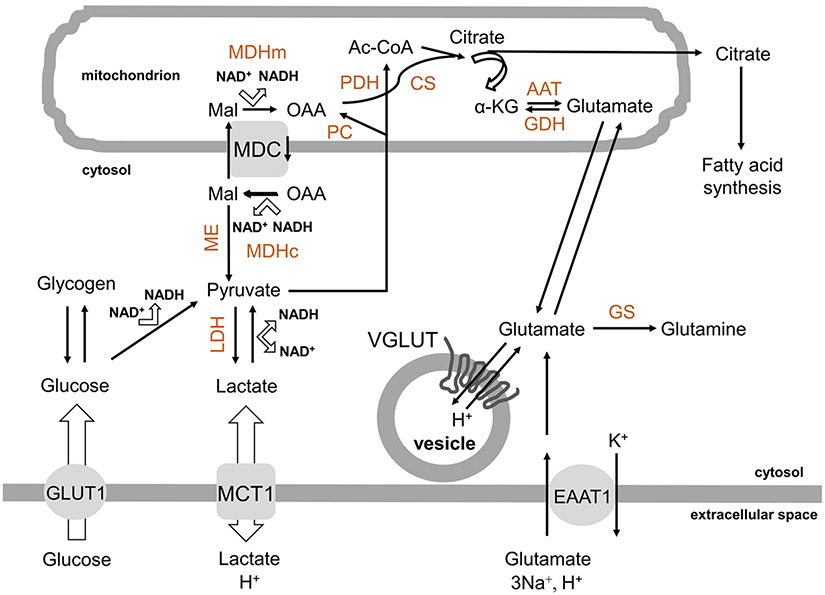Fig. 1.
Metabolic sources for de novo synthesis of glutamate in astrocytes. Glucose can be used as a carbon source for de novo synthesis of glutamate in astrocytes. This sugar is taken-up from the extracellular space via the plasmalemmal glucose transporter GLUT1 into the cytosol and then either stored in the polymeric from as glycogen from which can be retrieved on demand, or consumed in glycolysis to pyruvate and further to lactate to recuperate NAD+; the latter reaction is bidirectional, so that lactate can be converted to pyruvate. Lactate can be bidirectionally transported down its concentration gradient out/in astrocytes by the plasmalemmal proton-linked mono-carboxylate transporter MCT1. Pyruvate can be transported into mitochondria where it dually enters the citric/tricarboxylic acid (TCA) cycle via: (1) astrocyte-specific pyruvate carboxylase (PC), which converts pyruvate to oxaloacetate (OAA), and (2) pyruvate dehydrogenase (PDH), the first component enzyme of pyruvate dehydrogenase complex, transforming pyruvate into acetyl-coenzyme A (Ac-CoA). In turn, OAA and Ac-CoA, are condensed to citrate by citrate synthase (CS). Citrate can exit mitochondria into the cytosol where it is utilized in fatty acid synthesis, or feeds into the TCA cycle, which generates ATP and glutamate, the latter by transamination of α-ketoglutarate (α-KG) mainly by aspartate amino transferase (AAT). Glutamate that leaves mitochondria into the cytosol can be converted to glutamine due to the activity of glutamine synthetase (GS) and can be transported to glutamatergic secretory organelles/vesicles via proton-dependent vesicular glutamate transporters, VGLUTs. Glutamate can be taken up from the extracellular space by the plasmalemmal excitatory amino acids transporter 1 (EAAT1), which for each glutamate molecule also transports 3Na+ and 1 proton in, while 1 K+ out of cell); the reversal operation of this transporter is not in the realm of physiology. As extracellular glutamate concentration increases (to ~ 0.5 mM) in the extracellular space, a higher proportion of cytosolic glutamate is converted to α–KG and oxidized in the TCA cycle for energy. This conversion is primarily, but not exclusively, done via mitochondrial glutamate dehydrogenase (GDH). Some of OAA is also used in the malate shuttle, which involves: A mitochondrial dicarboxylate carrier (MDC) which transports malate (Mal) from the cytosol to the mitochondrion, while OAA in the opposite direction, and B two forms of malate dehydrogenases, mitochondrial (MDHm) and cytosolic (MDHc), differentiated not only by their location, but also in structure and catalysis reactions in opposite directions in this process. Malic enzyme (ME) in the cytosol can convert malate to pyruvate. Additional details on NAD+/NADH ratio related to glycolysis and the malate shuttle are available in Results

